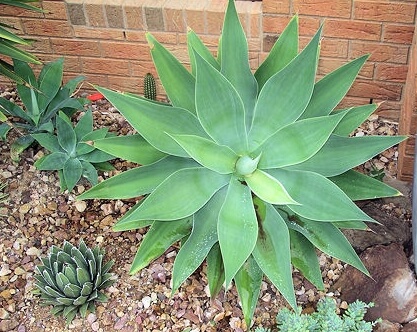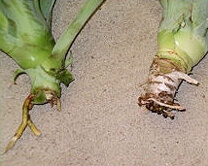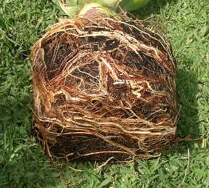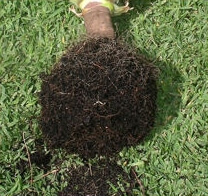Agave attenuata certainly is an Agave that has become quite popular in Australian gardens in recent times. Its large fleshy leaves really are quite attractive. The only problem with this plant is that as it grows a trunk it tends to fall over. Because of this though it is probably best to give it some space and let it eventually grow into a bush.
More...
In my garden though I placed two together in a confined area and as a consequence I’ve had to cut them back. The great thing about this Agave though is that it is very easy to propagate from. As the main stem grows it will also send off some offshoots called pups. When it does this you then have three options.
You can either leave it as it is to then grow into a bush, you can cut off some or all of the pups to propagate from and leave the main plant or if you like you can leave the pups to grow into a bush, cut off the main plant and then propagate from that.
In this instance I chose to cut off the main plants as they were growing as if they were falling over and obscuring some other plants.
Agave attenuata

In the photo above the two smaller plants on the left were the pups that were left after I cut off the main plant about 12 months ago. The main plant, I propagated and is now growing quite happily in a pot. The larger one on the right is now about to get the same treatment.

Agave attenuata pups. If I had more room I would have just left the 5 pups to grow into a bush.
In this photo you can see the stump that remains from the main plant as well as the 5 remaining pups and surprise, surprise, there is also a small Agave stricta ‘Nana’ growing as well that I forget was even there as it was obscured by the main Agave attenuata. Next I then removed 2 of the pups that I didn’t want and propagated from them.

Agave attenuata cuttings and pups.

Agave attenuata cutting in tubes.
I just soak the ends in some plant starter and then place them into some 5 cm tubes as shown and then just wait for the new roots to appear.

Agave attenuata cutting. This is the main plant that I cut off.
As far as the main plant goes I drip some of the above mentioned plant starter into the base of the cut trunk, let it soak in and then just plant it into a pot with normal potting mix. Once again it’s just a matter of waiting for the new roots to grow.
So there you have it, Agave attenuata. This Agave is easy to grow and easy to propagate from. It does grow a little quicker than some of the other agaves I have in my garden but I have noticed though it doesn’t appear to be as drought tolerant as some of the other agaves I have growing in my garden. Then again this Agave is still pretty drought tolerant compared to most other plants.
If you’d like to read about another Agave, Agave potatorum is another one that just like Agave attenuata is easy to grow and easy to propagate from.
Growing Agave attenuata in a Pot
Agaves are plants that lend themselves to be easily grown in pots and Agave attenuata is no exception. Because of its drought tolerance it’s a plant that won’t drop dead if you forget to water it every second day over summer.
Another great thing about Agave attenuata is that it’s really easy to propagate from cuttings and the one I’m about to show you is one that I propagated from a large cutting about 18 months ago.
I’d been meaning to repot it for sometime as when I propagated it I placed the cutting in the pot to about 3/4 of the depth of the pot and I could now see the roots starting to appear at the surface of the potting mix so I knew it was starting to get a bit root bound.
The other thing I’d done was place the old black plastic pot I planted inside a slightly larger clay pot. This is something I commonly do as black pots aren’t the most appealing pots and I don’t always like to plant straight into clay pots as they are porous and can dry out the potting mix before the plant gets the chance to take advantage of all the moisture.
My theory is that because the black pot has vertical ribs on the inside it makes the roots grow straight down and stops coiling. It also has better drainage holes at the base as most clay pots only have one small hole in the bottom than can clog with roots after a while (you can drill extra holes in clay pots with a masonry drill which is something I’ve also done).
Also when you want to repot your plant the plastic pot usually pulls quite easily out of the clay pot and then the plant pulls easily out of the plastic pot. Well that’s the theory anyway…but not in this case.
So when it came time to repot my Agave attenuata I couldn’t get the plastic pot out of the clay pot. The roots had coiled so tightly inside the plastic it had expanded so much that it was jammed inside the clay pot.
Now normally with most plants I would have had to break the clay pot to get it out but I decided that I was going to put this Agave attenuata to the test and see just how strong those roots were.
My solution was to pull on the short trunk as hard as I could and just pull it out (shock, horror). Now I have to say that there aren’t many plants that I’d do this to but I’d decided that the worst case scenario was that I’d just rip the roots right off the end of the trunk and I’d end up with a stem with no roots, which was pretty much exactly where I was with this plant 18 months ago when it was just a cutting.
So that’s exactly what I did. Pull on the trunk as hard as I could. First though I did loosen as much potting mix as I could in an attempt to get it out of the plastic pot. This, though, wasn’t going to happen as the roots had grown through the drainage holes and the only way to get it out of the plastic pot was to cut the roots off the bottom.
Unfortunately though these were still inside the clay pot so they were inaccessible. So once I’d loosened as much potting mix as possible I pulled on the trunk as hard as I could and eventually with quite a bit of effort, the Agave still attached to its roots, plus the plastic pot, came loose from the inside of the clay pot and here’s what it looked like. A tangled mess of roots (and just after 18 months).


Now the decision I had to make was what to do next. For me this was a pretty easy decision.
If you’ve ever watched gardening programs on TV I’m sure you’ve heard the presenter tell you that when planting a plant that you should “take it out of the pot and then carefully tease the coiled roots so they’re nice and straight”.
Well I’d have to say that this is good advice as roots will continue to grow in a circle in the ground if this is what they’d been doing in the pot but I’d also say that there’s no need to be careful about it.
I treat roots like I do branches and limbs and if they need to be pruned then that’s exactly what happens, they get pruned. Now I’d have to admit that this is a pretty extreme example of a plant that’s root bound but I also do this to any plant that I plant that has roots that have coiled around the inside of the pot.
Therefore the first thing I did was cut off the excess roots to get the plant out of the black plastic pot. This then exposed the extent of the roots inside the pot. As you can see it was quite root bound inside the pot as well so the next step was to cut off any coiled and crooked roots which was exactly what I did.


This then left me with a nice tidy root ball that was ready to be replanted. The other thing I did was soak the root ball in a diluted seaweed extract mixed with water for a few minutes to help it recover from “it’s surgery”.
It was then a case of either replanting it in the ground or back into the pot. I chose the latter and I used the same pot the second time around again as well. I will have to keep an eye on it though and maybe repot it in 12 months this time instead of 18.
So if you’re growing Agave attenuata in a pot don’t leave it too long to check out if it’s getting root bound and if it is, hopefully you won’t need to go to the same extent I did to remedy the problem.
Agave attenuata has a very extensive root system so I suppose at the end of the day it’s just as well, as that’s just one of the reasons why it’s such a drought tolerant plant.
Published on June 22, 2023 by AGT
Last Updated on January 28, 2024




